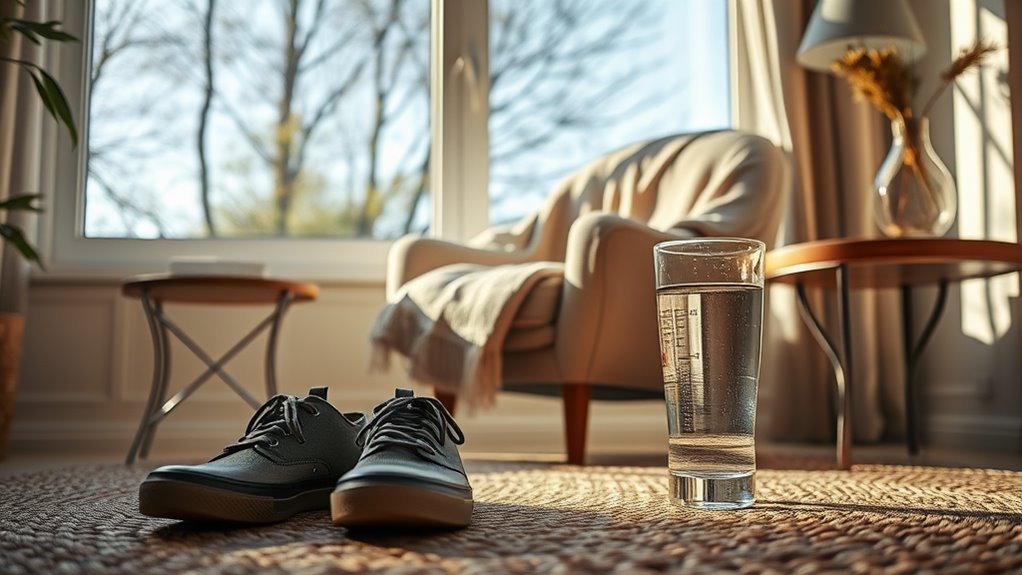The Simple Trick to Stop Restless Legs at Night!
You can stop restless legs at night with compression therapy, a proven method that calms those uncomfortable sensations. Simply wear compression socks or sleeves (15-20 mmHg pressure) about an hour before bedtime to improve circulation and soothe your nerves. Pair this with gentle stretching for enhanced relief. While compression offers quick results, understanding your triggers and making lifestyle changes will help you achieve lasting comfort.
Understanding Restless Legs Syndrome: Symptoms and Triggers
When restless legs syndrome (RLS) strikes, you’ll experience an overwhelming urge to move your legs, especially during periods of rest or inactivity. You’re not alone – this common condition affects millions of people worldwide, making peaceful sleep feel impossible.
The sensations you might feel include crawling, tingling, aching, or itching deep within your legs. These symptoms typically worsen in the evening and at night, making it challenging to relax and fall asleep.
Common triggers that many RLS sufferers share include caffeine, alcohol, stress, and certain medications.
Before trying various restless leg remedies, it’s important to identify your personal triggers. Keep a symptom diary to track when your RLS flares up and what might’ve caused it.
You’ll often notice patterns, like symptoms worsening after consuming certain foods or during particularly stressful periods. Understanding these triggers is your first step toward finding relief.
The Science Behind Nighttime Leg Restlessness
Although scientists haven’t fully unraveled the mystery of restless legs syndrome, research points to several biological factors at play. Your brain chemistry, particularly dopamine levels, plays a crucial role in controlling muscle movements. When these chemical signals get disrupted during the evening hours, you may experience those familiar uncomfortable sensations.
Like many of us who deal with nighttime restlessness, you’ll find that your symptoms often follow your body’s natural circadian rhythm. This internal clock affects how your nervous system functions throughout the day, with symptoms typically peaking at night.
-
Low iron levels in the brain can interfere with dopamine production and proper nerve function.
-
Genetics play a significant role, as RLS often runs in families and specific gene variants have been identified.
-
Your brain’s basal ganglia region, which controls movement, shows altered activity patterns during episodes.
Additionally, factors such as lifestyle choices including caffeine intake can influence RLS symptoms significantly.
Immediate Relief: The Game-Changing Compression Method
Understanding the science behind restless legs leads us to one of the most effective immediate solutions: compression therapy.
When you’re experiencing those uncomfortable sensations, try wrapping your legs in compression socks or sleeves – many fellow sufferers have found instant relief using this method.
The pressure from compression wear helps improve circulation and calms those misfiring nerves that cause your legs to feel restless.
You’ll want to choose compression gear that provides moderate pressure, typically between 15-20 mmHg. Start by putting them on about an hour before bedtime to give your legs time to adjust.
Like thousands of others who’ve discovered this technique, you might find that compression therapy becomes your go-to solution for peaceful nights.
For best results, pair your compression wear with gentle stretching and ensure they’re not too tight – you should feel supported, not constricted. Additionally, consider addressing iron deficiency as it can be a significant trigger for RLS symptoms.
Daily Habits That Make Restless Legs Worse
Many common daily habits can trigger or intensify your restless leg symptoms, making those nighttime hours even more challenging.
If you’re like most people dealing with RLS, you mightn’t realize that your daily routine could be working against you. Being aware of these triggers is your first step toward better sleep.
You’ll want to watch out for these major habit-related triggers that can make your restless legs worse:
- Consuming caffeine late in the day, including hidden sources like chocolate and certain sodas
- Using electronic devices before bed, as blue light exposure can disrupt your natural sleep rhythm
- Maintaining an irregular sleep schedule, which throws off your body’s internal clock
Natural Remedies and Lifestyle Changes for Long-Term Relief
When it comes to managing restless legs syndrome, natural remedies and lifestyle adjustments often provide significant relief without the side effects of prescription medications.
You’ll find that incorporating regular exercise, particularly yoga and gentle stretching, can help calm your restless legs and improve sleep quality.
Try establishing a consistent bedtime routine that includes warm baths or heating pads, as heat therapy relaxes muscles and promotes better circulation.
You can also massage your legs with essential oils like lavender or peppermint to soothe discomfort. Many people find relief by supplementing with magnesium, iron, or vitamin D after consulting their healthcare provider.
Consider practicing stress-reduction techniques such as meditation or deep breathing exercises, as anxiety often worsens symptoms.
In addition, maintaining a balanced diet focusing on iron-rich foods can significantly impact your overall symptoms.
You might also benefit from acupuncture or compression socks to improve blood flow.
Making these natural approaches part of your daily routine can lead to lasting improvement in your RLS symptoms.




